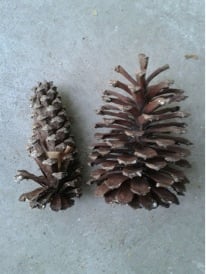Animals care for their young, but can trees care for future generations too? We happened upon a really cool phenomenon when we noticed two pinecones from the same tree. Both were nearly the same size when we found them in the park. One we left outside in the rain, the other we left in the garage. The large pinecone closed up when it rained outside! It was protecting the seeds and keeping them from drowning in the downpour. When it stopped raining for several days, the pinecones opened back up to allow the dry seeds to fly away and sprout somewhere new.
You will need:
- Two similarly sized pinecones
- A bowl of water
- Time
Set one of the pinecones in the bowl of water and wait a few hours. Within 15-30 minutes you should see the pinecone start to contract. It may take longer for older pinecones.
Why? Well here’s an answer from Walter Reeves, the Georgia Gardener.
The process of opening and closing in water is called osmotic pressure.
Basically, the cones close up because the cells at the base of each scale absorb water …and the increased water pressure in the cells cause the scale to fold forward.
When the cells dry out, the scales fold backward and open the cone up.
The reason this benefits the tree is that the dry, mature cone effectively releases its seed so the pine can procreate.
Jayne’s book recommendation to go with this activity: Redwoods by Jason Chin (Flashpoint 2009). From Carolyn Phelan’s Booklist Starred review: “Before the title page, the first illustration shows a boy finding a book called Redwoods while waiting for his subway train. Remarkably, the boy pictured on the cover looks like him, though on the title page, a girl in an orange sweater walks through the trees. The text is straightforward nonfiction: an informative guide to redwood trees. Meanwhile, the illustrations create an imaginative drama that highlights the facts. When he is reading that some trees alive today sprouted during Roman times, the boy is shown sharing a seat with a Roman Legionnaire and a citizen wearing a toga. When he leaves the subway, he emerges into a stand of redwoods, which he thoroughly explores from forest floor to canopy. A height comparison of trees and skyscrapers brings him back to the city, where he leaves the book on a park bench. The illustrations conclude with the girl in an orange sweater picking up the book and beginning her own adventure.”
Jayne Moraski runs a website identifying simple ways that families with elementary age-kids can spend time TV-free at www.jaynemoraski.tumblr.com. She can also be found on Twitter @Jmoraski. She has written public relations and travel articles for the Florida tourism industry, academic publications in non-profit management, and several children’s magazines stories.
About the Author

Guest
We welcome guest contributors who graciously volunteer their writing for our readers. Please support our guest writers by visiting their sites, purchasing their work, and leaving comments to thank them for sharing their gifts here on CatholicMom.com. To inquire about serving as a guest contributor, contact editor@CatholicMom.com.



.png?width=1806&height=731&name=CatholicMom_hcfm_logo1_pos_871c_2728c%20(002).png)
Comments